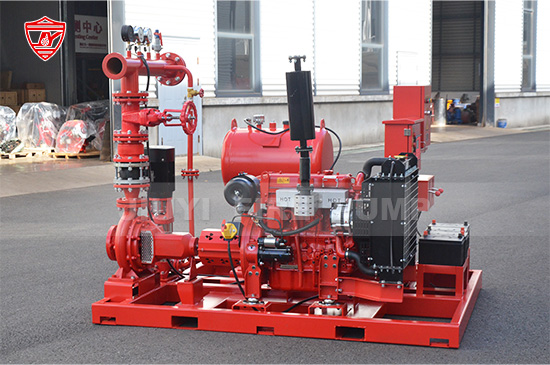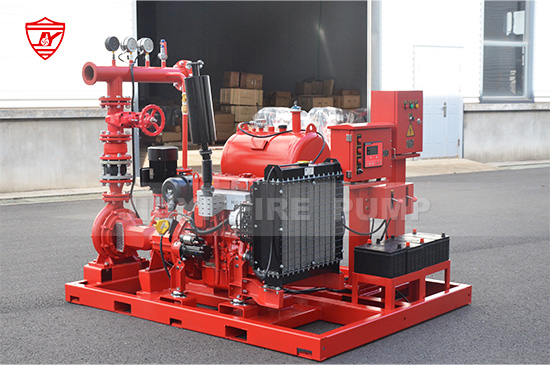In fire protection systems, reliability is not optional — it is the foundation of safety. A fire pump’s role is to ensure that water pressure and flow are sufficient to control or extinguish a fire when needed. But what happens if the main pump fails? That’s where the duty and standby configuration comes in — a design approach that ensures uninterrupted fire protection even during mechanical failure, maintenance, or emergency conditions.
This article explains what duty and standby configurations mean, their importance, how they comply with NFPA 20, and key considerations when selecting and installing them.

The duty fire pump (also called the main pump) is the primary unit responsible for supplying the required water pressure and flow during a fire emergency. It starts automatically when system pressure drops below a set point and operates until manual shutdown after the fire event.
The duty pump is sized according to system demand — usually based on the most hydraulically remote sprinkler or hydrant. It must meet NFPA 20 and local fire codes, ensuring sufficient capacity and pressure for the building’s fire protection system.
The standby fire pump, also called a backup pump or redundant pump, serves as a reserve. If the duty pump fails to start or deliver the required performance, the standby unit automatically takes over to maintain fire protection coverage.
This configuration significantly increases system reliability, especially in critical facilities such as:
High-rise buildings
Hospitals and airports
Power plants and data centers
Industrial plants and refineries
In essence, the standby pump is insurance — it ensures that even if one pump fails, the system remains capable of full operation.
A single fire pump, no matter how well maintained, is still a potential point of failure. Electrical faults, mechanical wear, or human error could compromise performance. Adding a standby pump mitigates this risk by providing a redundant source of water supply.
NFPA 20 — the Standard for the Installation of Stationary Pumps for Fire Protection — recognizes the need for redundancy in certain cases. Many local authorities, insurers, and safety consultants recommend or require standby configurations in high-risk buildings or critical infrastructure.
In some regions, building codes mandate at least two pumps (duty and standby) for facilities with large fire zones, critical operations, or life-safety importance.
With a standby configuration, maintenance or repair of the duty pump can be carried out without compromising protection. The standby unit can temporarily serve as the duty pump, keeping the system operational 24/7.
In a fire emergency, seconds count. The assurance that there is a fully functional standby pump ready to operate can make a critical difference — both in property protection and in saving lives.
This is the most common configuration in medium to large fire protection systems. One pump serves as the main (duty) pump, and the other stands by. Both pumps are of identical capacity and specifications to ensure seamless operation.
Each pump is connected to a dedicated controller — typically one electric motor-driven pump and one diesel engine-driven pump to provide power-source redundancy.
In larger facilities with high flow demand, two pumps may run as duty pumps simultaneously, supported by a single standby pump. This setup ensures that even if one of the duty pumps fails, the standby pump can immediately replace it.
Critical facilities such as petrochemical plants or airports may have several pumps — for example, three duty pumps and two standby units. This design provides layered redundancy for complex fire protection networks.
When configuring duty and standby systems, power source diversity is a vital consideration. NFPA 20 recommends that standby pumps be driven by a different power source than the duty pump to ensure continued operation even during a power outage.
Typical combinations include:
Duty pump: Electric motor-driven
Standby pump: Diesel engine-driven
This design ensures that if electrical power is lost during a fire (which is common), the diesel-driven standby pump can still supply water to the system.
Each fire pump — duty or standby — must have its own fire pump controller. These controllers monitor pressure in the fire protection system and automatically start the pump when pressure falls below the designated threshold.
In a duty-standby setup, the system can be designed for:
Sequential start: The duty pump starts first; if pressure is not restored within a set time, the standby pump starts automatically.
Simultaneous start: Both pumps start together to ensure immediate pressure recovery.
Automatic changeover ensures that the fire protection system reacts instantly, with minimal human intervention.
NFPA 20 provides comprehensive requirements for fire pump installation, configuration, and testing. While it does not always require a standby pump, it encourages redundancy where system reliability is paramount.
Key NFPA 20 considerations for duty and standby systems include:
Each pump must be independently controlled and protected.
Power supplies for electric pumps must be independent and reliable.
Diesel-driven pumps must include fuel storage sufficient for at least 8 hours of continuous operation.
The system must include pressure maintenance (jockey) pumps to prevent unnecessary fire pump starts.
In addition, regional standards such as UL Listing, FM Approval, and local fire codes may further specify requirements for duty and standby arrangements. Always consult local regulations and authorities having jurisdiction (AHJ).
A fire pump system is only as reliable as its maintenance schedule. Both duty and standby pumps must be tested and maintained according to NFPA 25 — Standard for the Inspection, Testing, and Maintenance of Water-Based Fire Protection Systems.
Weekly Start Test: Verify that both pumps start automatically and run smoothly.
Monthly Inspection: Check controllers, batteries, valves, and power supply integrity.
Annual Flow Test: Conduct a full-capacity performance test to ensure that both pumps meet rated flow and pressure.
Maintenance Rotation: Alternate duty and standby roles periodically to ensure equal wear and readiness.
Regular maintenance guarantees that when the fire alarm sounds, both pumps are ready to perform flawlessly.
When designing or upgrading a fire pump system, consider these key factors:
Building size and risk category: Larger and high-risk facilities benefit most from standby redundancy.
Water supply reliability: If your water source is inconsistent, redundancy in pumping ensures steady delivery.
Power availability: Consider the risk of power loss — a diesel-driven standby pump is often recommended.
System demand: Ensure that all pumps (duty and standby) meet or exceed required flow and pressure.
Compliance: Always align with NFPA 20 and local codes for installation and testing.
Partnering with a certified fire pump manufacturer ensures your configuration is correctly designed, assembled, and tested to international standards.

A fire pump duty and standby configuration is not just an engineering decision — it’s a life-safety commitment. By ensuring continuous operation even during pump failure or maintenance, it provides the highest level of reliability in fire protection systems.
For buildings where safety and uptime are critical, the investment in a duty and standby configuration is not optional — it is essential. As a professional manufacturer of fire pumps, we strongly recommend evaluating your system’s redundancy to ensure compliance, reliability, and peace of mind in every emergency.